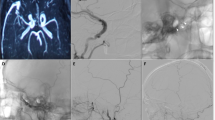Abstract
Background
Dural arteriovenous fistulas (dAVFs) at the superior petrosal sinus are a rare but important subtype that pose a high risk of mortality and morbidity. Treatment for these lesions can be challenging with stand-alone endovascular methods.
Methods
We describe our “in-out-in” technique for disconnecting dAVFs at the superior petrosal sinus, which includes definitive sacrifice of the superior petrosal sinus and the transverse sigmoid sinus, if involved. This method achieves complete fistula obliteration and minimizes recurrence risk with new arterial feeders.
Conclusions
The in-out-in technique is a safe and effective approach for the treatment of dAVFs involving the superior petrosal sinus.


Similar content being viewed by others
Data availability
All data are presented in the paper.
Code availability
Not applicable.
References
Abecassis IJ, Meyer RM, Levitt MR, Sheehan JP, Chen CJ, Gross BA, Smith J, Fox WC, Giordan E, Lanzino G, Starke RM, Sur S, Potgieser ARE, van Dijk JMC, Durnford A, Bulters D, Satomi J, Tada Y, Kwasnicki A, Amin-Hanjani S, Alaraj A, Samaniego EA, Hayakawa M, Derdeyn CP, Winkler E, Abla A, Lai PMR, Du R, Guniganti R, Kansagra AP, Zipfel GJ, Kim LJ, Research CfDAFO, Collaborators C (2022) Recurrence after cure in cranial dural arteriovenous fistulas: a collaborative effort by the Consortium for Dural Arteriovenous Fistula Outcomes Research (CONDOR). J Neurosurg 136:981–989. https://doi.org/10.3171/2021.1.JNS202033
Bhatia KD, Lee H, Kortman H, Klostranec J, Guest W, Wälchli T, Radovanovic I, Krings T, Pereira VM (2022) Endovascular management of intracranial dural AVFs: principles. AJNR Am J Neuroradiol 43:160–166. https://doi.org/10.3174/ajnr.A7304
Churojana A, Chailerd O, Mongkolratnan A, Sangpetngam B, Withayasuk P, Chankaew E, Aurboonyawat T, Songsaeng D (2018) The effectiveness of dural venous sinus sacrifice as a treatment of aggressive type cranial dural arteriovenous fistulas. Asian J Neurosurg 13:749–753. https://doi.org/10.4103/ajns.AJNS_31_18
Cognard C, Gobin YP, Pierot L, Bailly AL, Houdart E, Casasco A, Chiras J, Merland JJ (1995) Cerebral dural arteriovenous fistulas: clinical and angiographic correlation with a revised classification of venous drainage. Radiology 194:671–680. https://doi.org/10.1148/radiology.194.3.7862961
Hou K, Lv X, Qu L, Guo Y, Xu K, Yu J (2020) Endovascular treatment for dural arteriovenous fistulas in the petroclival region. Int J Med Sci 17:3020–3030. https://doi.org/10.7150/ijms.47365
Hwang G, Kang HS, Oh CW, Kwon OK (2011) Surgical obliteration in superior petrosal sinus dural arteriovenous fistula. J Korean Neurosurg Soc 49:222–225. https://doi.org/10.3340/jkns.2011.49.4.222
Mortazavi MM, Cox MA, Saker E, Krishnamurthy S, Verma K, Griessenauer CJ, Loukas M, Oskouian RJ, Tubbs RS (2018) The superior petrosal sinus: a review of anatomy, embryology, pathology, and neurosurgical relevance. Neurosurg Rev 41:713–718. https://doi.org/10.1007/s10143-016-0785-9
Patel B, Chatterjee A, Petr O, Collins H, Lanzino G, Derdeyn CP, Zipfel GJ (2019) T2-weighted-fluid-attenuated inversion recovery hyperintensity on magnetic resonance imaging is associated with aggressive symptoms in patients with dural arteriovenous fistulas. Stroke 50:2565–2567. https://doi.org/10.1161/STROKEAHA.118.024285
Stapleton CJ, Patel AP, Walcott BP, Torok CM, Koch MJ, Leslie-Mazwi TM, Rabinov JD, Butler WE, Patel AB (2018) Surgical management of superior petrosal sinus dural arteriovenous fistulae with dominant internal carotid artery supply. Interv Neuroradiol 24:331–338. https://doi.org/10.1177/1591019917754038
Sun L, Ren J, Wang L, Li J, He C, Ye M, Li G, Zhang H (2020) Preservation of coexisting normal superior petrosal vein in the microsurgical treatment of superior petrosal sinus dural arteriovenous fistulas assisted by indocyanine green video angiography. World Neurosurg 141:e836–e843. https://doi.org/10.1016/j.wneu.2020.06.048
Acknowledgements
We thank Vance Mortimer for assistance in preparing the surgical video and Kristin Kraus for editorial assistance.
Author information
Authors and Affiliations
Contributions
Ramesh Grandhi: methodology, writing — original draft, visualization.
Cameron Rawanduzy: methodology, writing — original draft, visualization.
Robert C. Rennert: methodology, writing — original draft, visualization.
William T. Couldwell: conceptualization, resources, supervision, project administration, writing — review and editing.
Corresponding author
Ethics declarations
Ethical approval
Approval from the institutional review board is waived for case reports. All procedures performed in studies involving human participants were in accordance with the ethical standards of the University of Utah and with the 1964 Helsinki declaration and its later amendments or comparable ethical standards.
Consent to participate
The patients consented to participate.
Consent for publication
The patients consented to the publication of their cases in this paper.
Conflict of interest
The authors declare no competing interests.
Additional information
Publisher's Note
Springer Nature remains neutral with regard to jurisdictional claims in published maps and institutional affiliations.
Key points
• dAVFs of the SPS are an uncommon but morbid subtype of cranial dAVF.
• SPS dAVFs often present with symptoms of myelopathy or hemorrhage.
• CVR indicates a high-risk dAVF.
• T2/FLAIR abnormalities may suggest an aggressive nature of the dAVF and indicate treatment.
• Endovascular embolization is challenging in dAVFs involving the SPS.
• Sacrifice of the TSS junction and SPVC, in addition to the fistulous outflow, prevents recurrence.
• Preoperative digital subtraction angiography is essential to understand the arterial supply and venous drainage of the fistula.
• The SPVC draining patterns should be understood preoperatively.
• Use of video angiography and neuromonitoring can ensure safe ligation of the fistula intraoperatively.
• The goals of surgery and the possibility of symptom relief should be discussed in depth with the patient.
Supplementary Information
Below is the link to the electronic supplementary material.
Supplementary file1 (MP4 379874 KB)
Rights and permissions
Springer Nature or its licensor (e.g. a society or other partner) holds exclusive rights to this article under a publishing agreement with the author(s) or other rightsholder(s); author self-archiving of the accepted manuscript version of this article is solely governed by the terms of such publishing agreement and applicable law.
About this article
Cite this article
Rawanduzy, C.A., Grandhi, R., Rennert, R.C. et al. In-out-in technique for petrosal sinus dural arteriovenous fistula obliteration: How I Do It. Acta Neurochir 165, 3793–3798 (2023). https://doi.org/10.1007/s00701-023-05822-0
Received:
Accepted:
Published:
Issue Date:
DOI: https://doi.org/10.1007/s00701-023-05822-0




